Charles E W Bean, Diaries, AWM38 3DRL 606/272/1 - 1917 - 1932 - Part 11

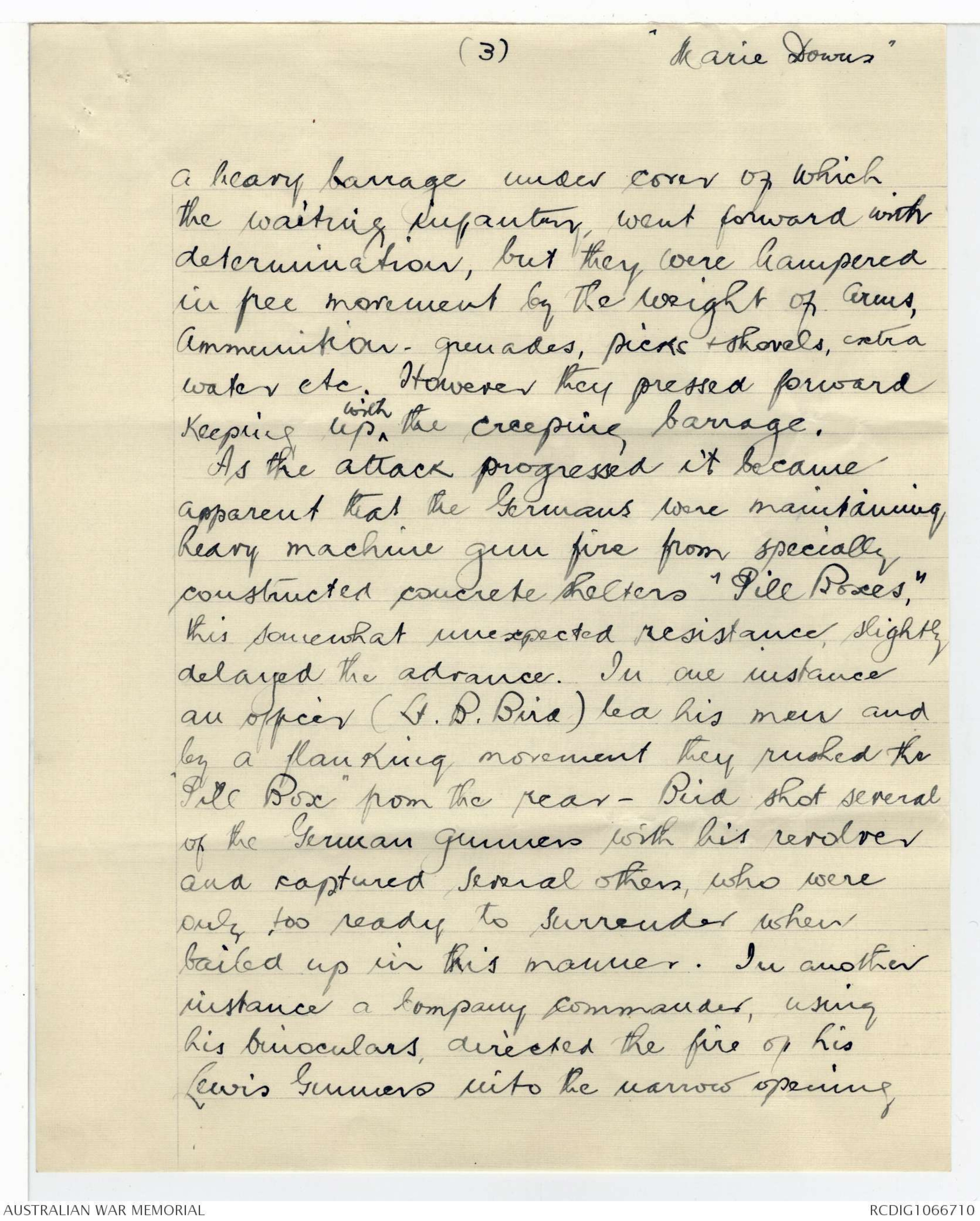
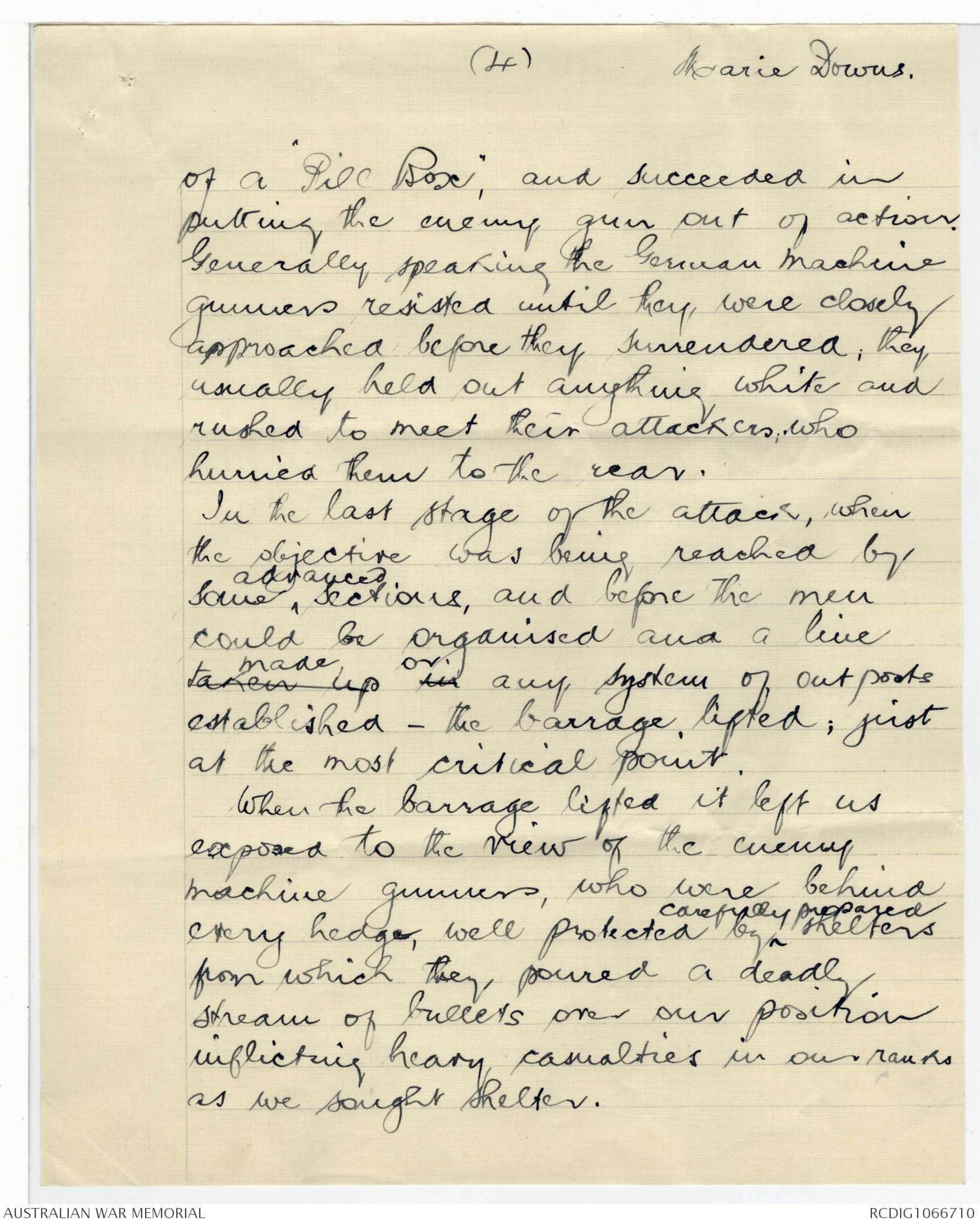
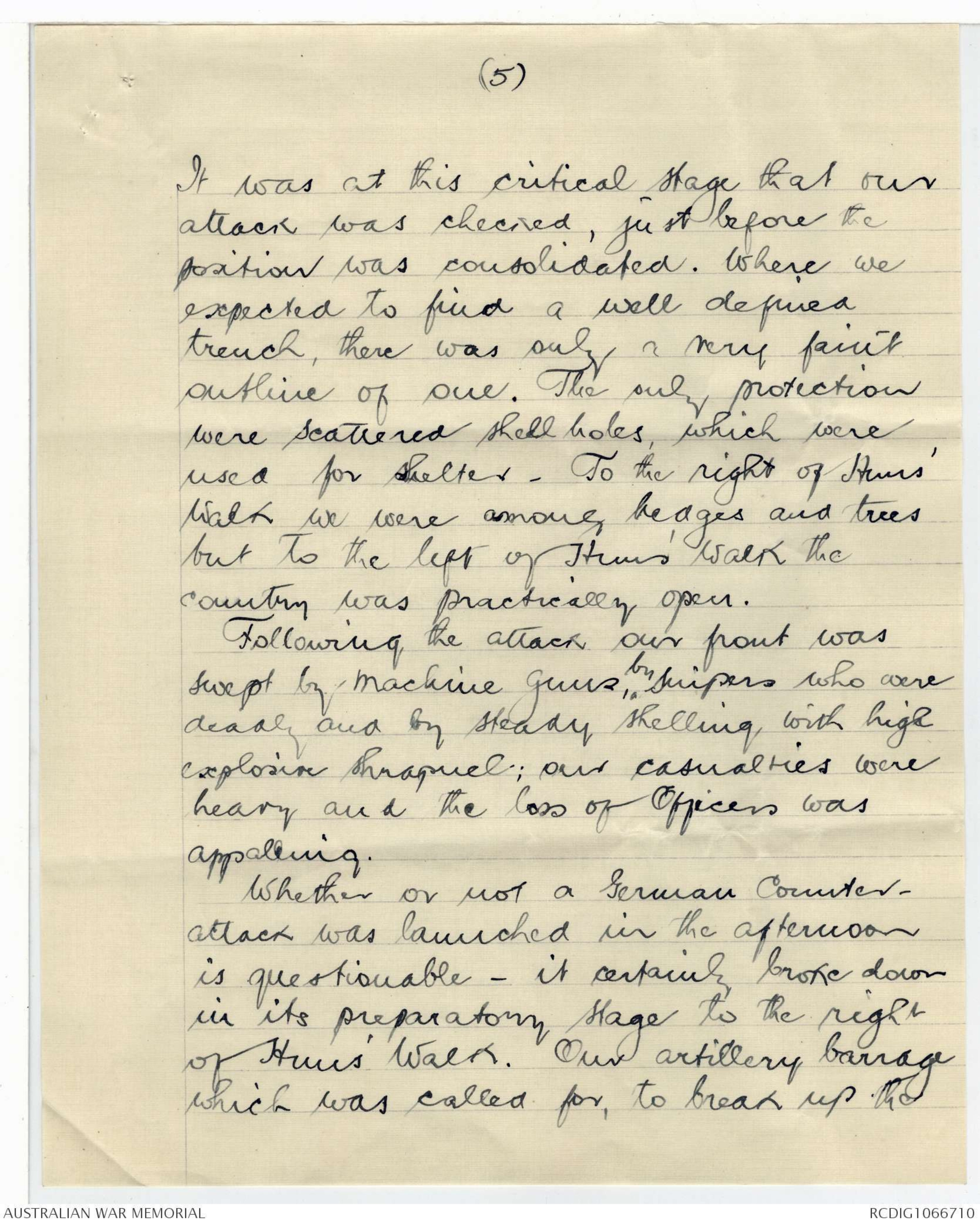
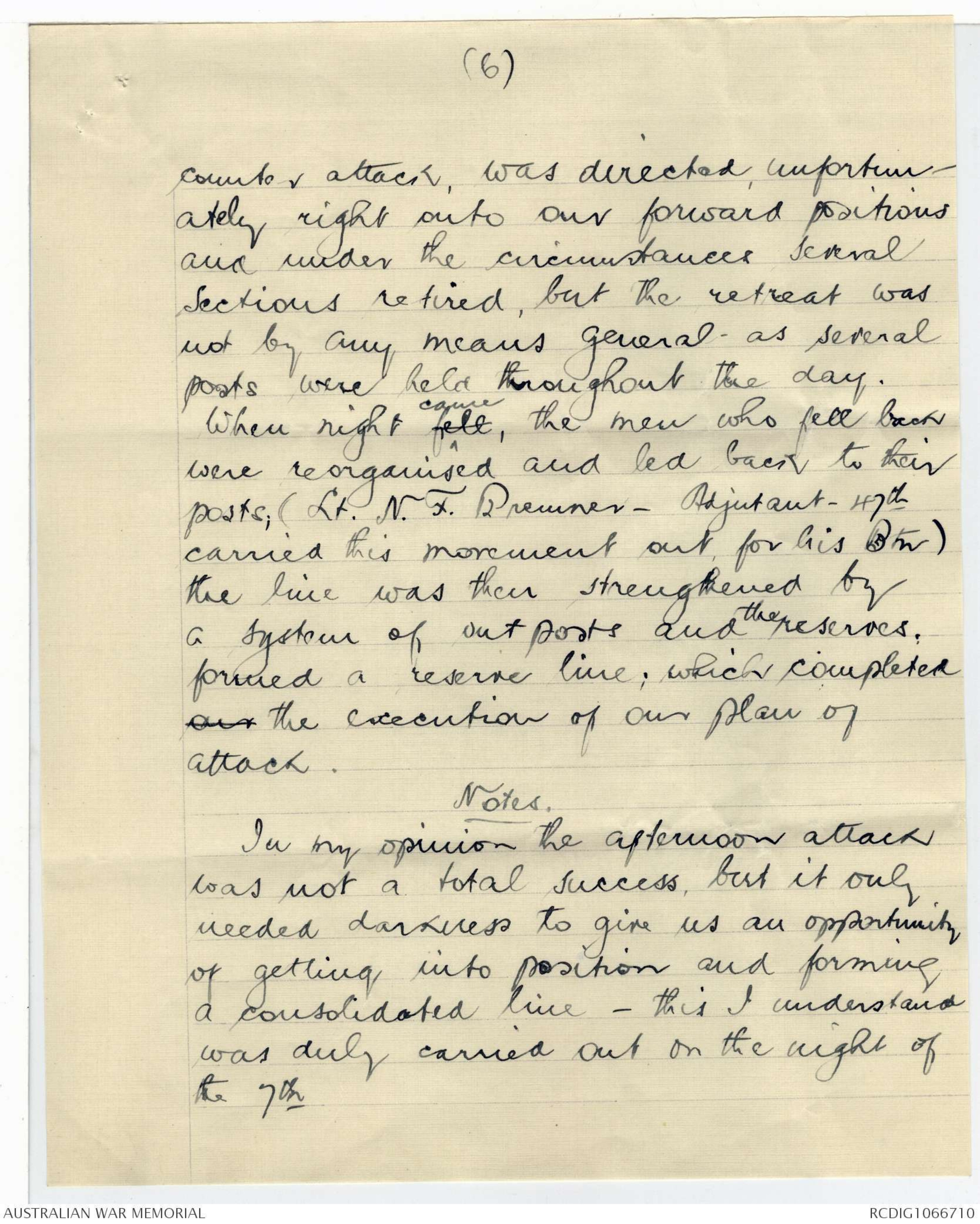
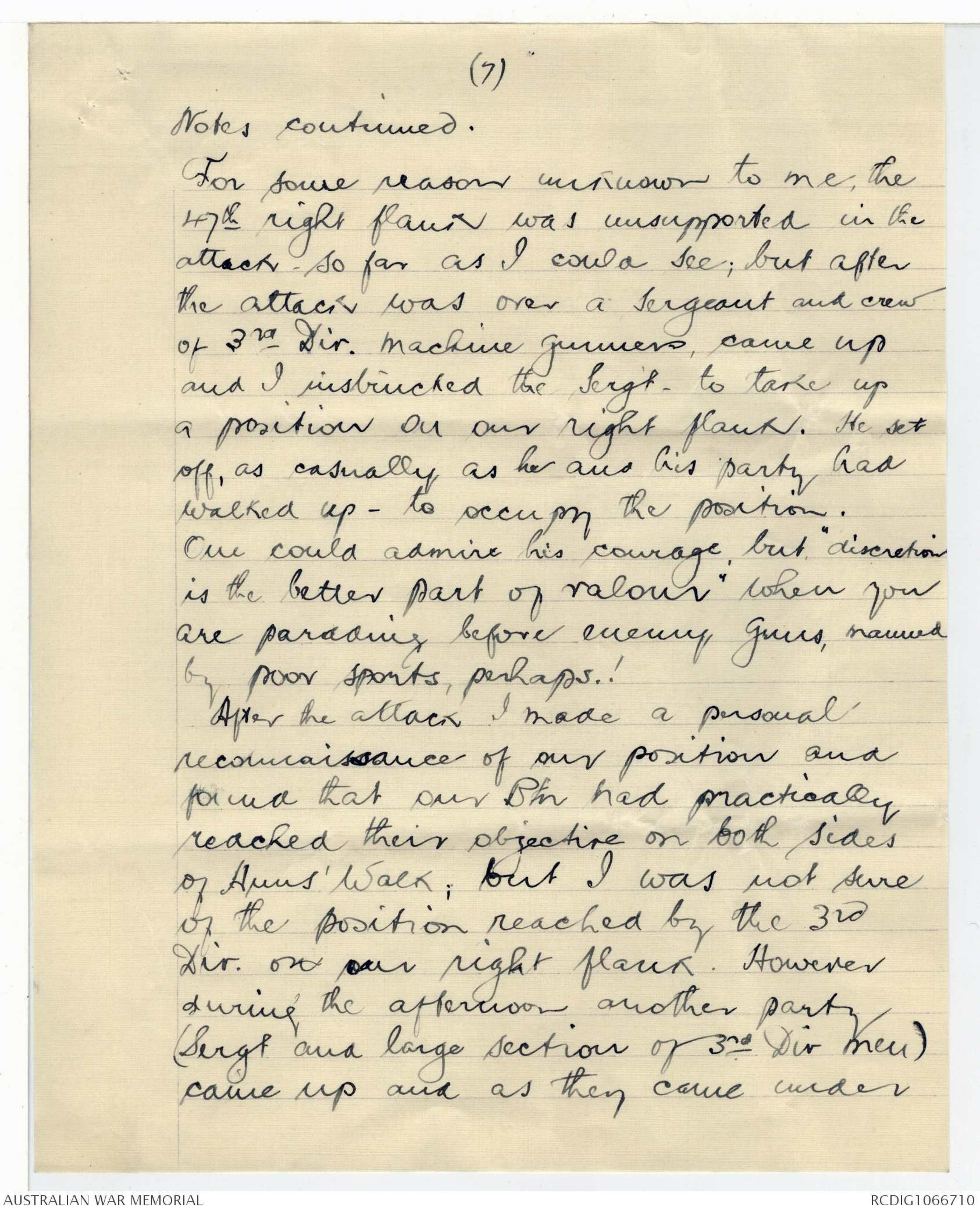
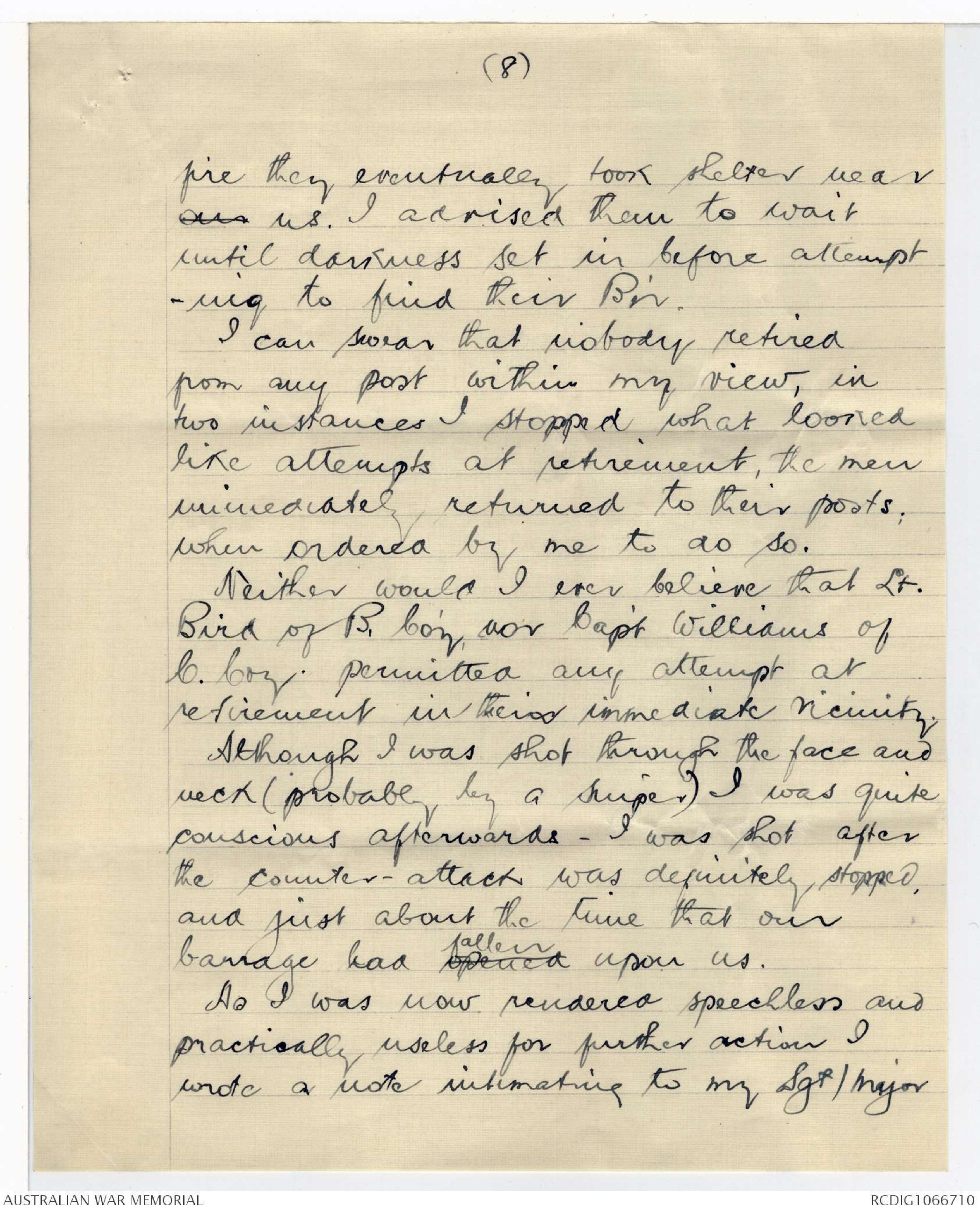
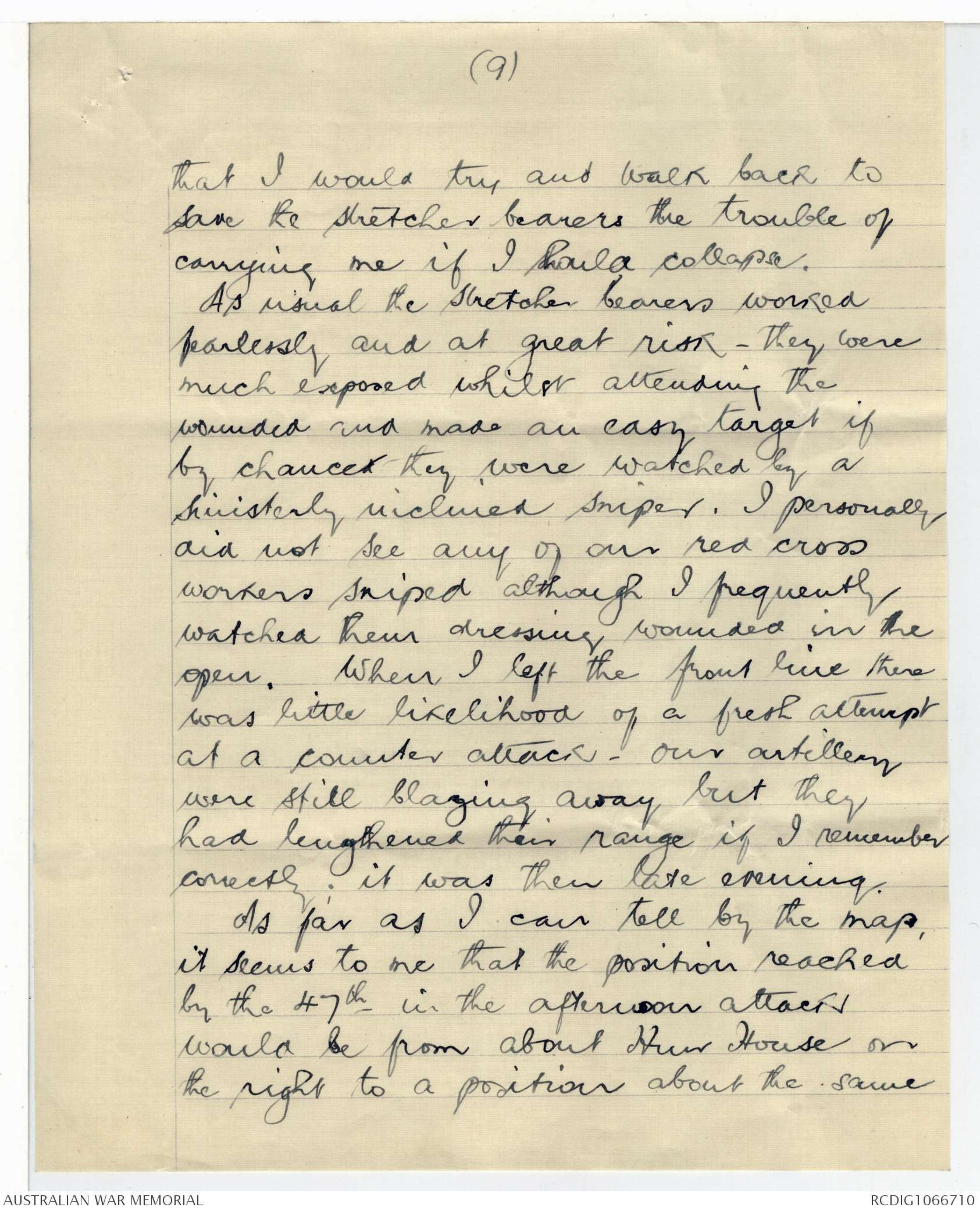
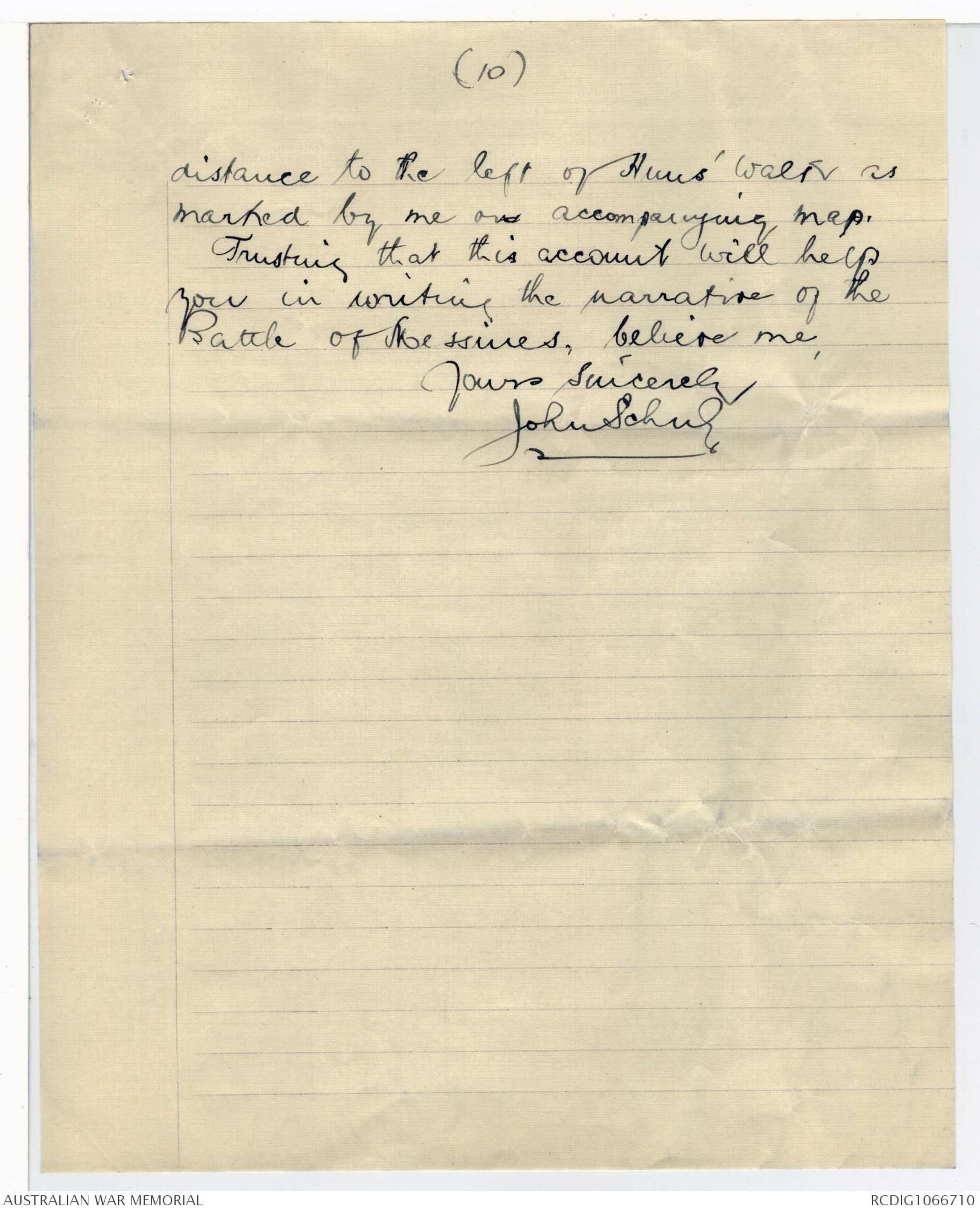
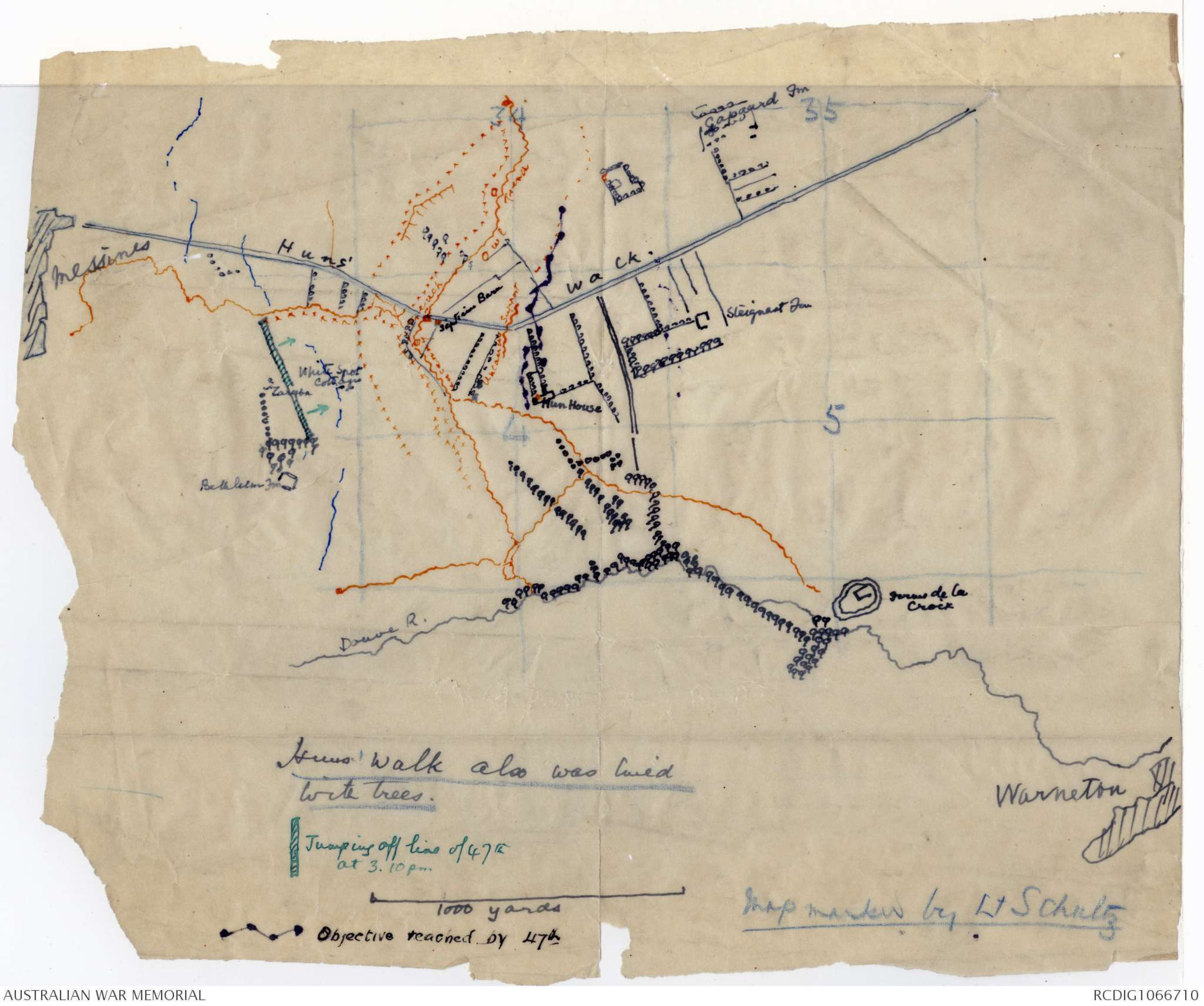
(2)
"Marie Downs."
13th May 1931.
To take part in the afternoon attack "Battle
of Messines" the 47th moved forward
from reserves, the morning of the 7th.
Messines lay to the left as the 47th advanced
to their jumping off position. Advancing
in artillery formation, the troops moved
forward across open country, unprotected
by any natural cover or dead ground
and although subjected to sustained
but not heavy shelling; they moved,
keeping correct formation and in
an exemplary spirit, reached their
jumping off line between 1.30 & 2 p.m.
As the attack had been ordered,
originally, to take place an hour
earlier than it did; the delay caused
some irritation to the assembled troops
who were ^kept waiting under steady artillery fire.
Further casualties received in the
interval (Capt. Davy was killed at this
stage and I took his place as O/C.
D. Company.)
The afternoon attack was launched with
(3) "Marie Downs"
a heavy barrage under cover of which
the waiting infantry, went forward with
determination, but they were hampered
in free movement by the weight of arms,
ammunition -grenades, picks & shovels, extra
water etc. However they pressed forward
keeping up ^with the creeping barrage.
As the attack progressed it became
apparent that the Germans were maintaining
heavy machine gun fire from specially
constructed concrete shelters "Pill Boxes,"
this somewhat unexpected resistance, slightly
delayed the advance. In one instance
an officer (Lt. B. Bird) led his men and
by a flanking movement they rushed the
"Pill Box" from the rear - Bird shot several
of the German gunners with his revolver
and captured several others, who were
only too ready to surrender when
bailed up in this manner. In another
instance a company commander, using
his binoculars, directed the fire of his
Lewis Gunners into the narrow opening
(4) Marie Downs.
of a "Pill Box", and succeeded in
putting the enemy gun out of action.
Generally speaking the German Machine
gunners resisted until they were closely
approached before they surrendered, they
usually held out anything white and
rushed to meet their attackers, who
hurried them to the rear.
In the last stage of the attacks, when
the objective was being reached by
some ^advanced sections, and before the men
could be organised and a line
taken up made or in any system of outposts
established - the barrage lifted; just
at the most critical point.
When the barrage lifted it left us
exposed to the view of the enemy
machine gunners, who were behind
every hedge, well protected by ^carefully prepared shelters
from which they poured a deadly
stream of bullets over our position
inflicting heavy casualties in our ranks
as we sought shelter.
(5)
It was at this critical stage that our
attack was checked, just before the
position was consolidated. Where we
expected to find a well defined
trench, there was only very faint
outline of one. The only protection
were scattered shell holes, which were
used for shelter. To the right of Huns'
Walk we were among hedges and trees
but to the left of Huns' Walk the
country was practically open.
Following the attack our front was
swept by Machine Guns, by snipers who were
deadly and by steady shelling with high
explosive shrapnel; our casualties were
heavy and the loss of Officers was
appalling.
Whether or not a German Counter-attack
was launched in the afternoon
is questionable - it certainly broke down
in its preparatory stage to the right
of Huns' Walk. Our artillery barrage
which was called for, to break up the
(6)
counter attack, was directed, unfortunately
right onto our forward positions
and under the circumstances several
sections retired, but the retreat was
not by any means general-as several
posts were held throughout the day.
When night fell, ^came, the men who fell back
were reorganised and led back to their
posts; (Lt. N. F. Bremner - Adjutant - 47th
carried this movement out for his Btn)
the line was their strengthened by
a system of outposts and the reserves.
formed a reserve line; which completedour the execution of our plan of
attack.
Notes.
In my opinion the afternoon attack
was not a total success, but it only
needed darkness to give us an opportunity
of getting into position and forming
a consolidated line - this I understand
was duly carried out on the night of
the 7th
(7)
Notes continued.
For some reason unknown to me, the
47th right flank was unsupported in the
attack- so far as I could see; but after
the attacks was over a Sergeant and crew
of 3rd Div. Machine gunners came up
and I instructed the Sergt. to take up
a position on our right flank. He set
off, as casually as he and his party had
walked up - to occupy the position.
One could admire his courage, but "discretion
is the better part of valour" when you
are parading before enemy guns, named
by poor sports, perhaps.!
After the attack I made a personal
reconnaissance of our position and
found that our Btn had practically
reached their objective on both sides
of Huns' Walk; but I was not sure
of the position reached by the 3rd
Div. on our right flank. However
during the afternoon another party
(Sergt and large section of 3rd Div men),
came up and as they came under
(8)
fire they eventually took shelter nearour us. I advised them to wait
until darkness set in before attempting
to find their Bn.
I can swear that nobody retired
from any post within my view, in
two instances I stopped what looked
like attempts at retirement, the men
immediately returned to their posts,
when ordered by me to do so.
Neither would I ever believe that Lt.
Bird of B. Coy nor Capt Williams of
C. Coy permitted any attempt at
retirement in their immediate vicinity.
Although I was shot through the face and
neck (probably by a sniper) I was quite
conscious afterwards - I was shot after
the counter-attack was definitely stopped,
and just about the time that our
barrage had opened fallen upon us.
As I was now rendered speechless and
practically useless for further action I
wrote a note intimating to my Sgt/Major
(9)
that I would try and walk back to
save the stretcher bearers the trouble of
carrying me if I should collapse.
As usual the stretcher bearers worked
fearlessly, and at great risk -they were
much exposed whilst attending the
wounded and made an easy target if
by chanced they were watched by a
sinisterly inclined sniper. I personally
did not see any of our red cross
workers sniped although I frequently
watched them dressing wounded in the
open. When I left the front line there
was little likelihood of a fresh attempt
at a counter attack - our artillery
were still blazing away but they
had lengthened their range if I remember
correctly; it was then late evening.
As far as I can tell by the map
it seems to me that the position reached
by the 47th in the afternoon attack
would be from about Hun House on
the right to a position about the same
(10)
distance to the left of Huns' Walk as
marked by me on accompanying Map.
Trusting that this account will help
you in writing the narrative of the
Battle of Messines, believe me,
Yours Sincerely
John Shulz.
Map marked by Lt Schultz
Map - see original document
 Maralyn K
Maralyn KThis transcription item is now locked to you for editing. To release the lock either Save your changes or Cancel.
This lock will be automatically released after 60 minutes of inactivity.